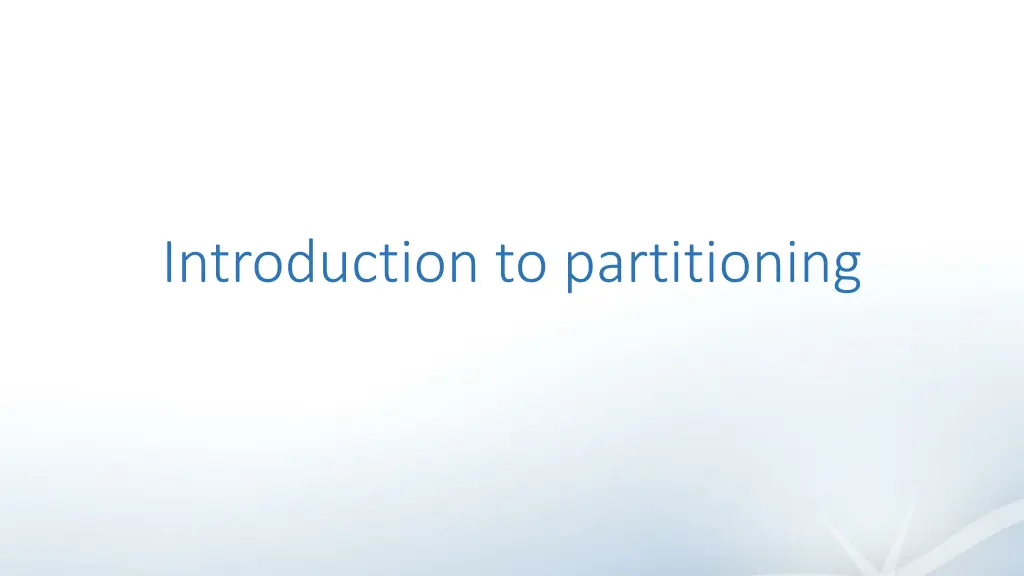
Understanding SQL Server Partitioning Concepts
Gain insights into SQL Server partitioning, covering definition, benefits, drawbacks, key considerations, and implementation steps. Learn how to split tables, manage partitions, optimize performance, and more.
Download Presentation

Please find below an Image/Link to download the presentation.
The content on the website is provided AS IS for your information and personal use only. It may not be sold, licensed, or shared on other websites without obtaining consent from the author. If you encounter any issues during the download, it is possible that the publisher has removed the file from their server.
You are allowed to download the files provided on this website for personal or commercial use, subject to the condition that they are used lawfully. All files are the property of their respective owners.
The content on the website is provided AS IS for your information and personal use only. It may not be sold, licensed, or shared on other websites without obtaining consent from the author.
E N D
Presentation Transcript
About Me Andrew Pruski @dbafromthecold dbafromthecold@gmail.com www.dbafromthecold.com SQL Server DBA & Data Platform MVP Originally from Wales, now living in Dublin
Session Aim To give you a base of knowledge to work with partitioning in SQL Server
Agenda Partitioning Definition Partitioning Key Partition Functions & Schemes Indexing Considerations Splitting, Merging & Switching Partitions Implementing Sliding Windows Filegroup Restores
Partitioning Definition Splitting a table horizontally into different units Units can be spread across different physical locations Limit of 15,000 partitions per table Primarily for maintenance of data Specialist functions available to manage data
Benefits Partitioned tables appear as normal tables Data is automatically mapped to the correct partition Specialist operations allow for easy management of data Individual partitions can be compressed Individual partitions can be rebuilt
Drawbacks Requires management of partitions and filegroups Specialist operations can be blocked by DML operations Foreign keys referencing partitioned table will prevent switch operations Performance of queries not referencing the partitioning key will be affected
Partitioning key Column in the table which defines partition boundaries How is the data going to be split? Archiving/retention policy for the data? How is the table going to be queried? All column types except timestamp, ntext, text, image, xml, varchar(max), nvarchar(max), or varbinary(max)
Partition Functions Maps rows in the table to a partition CREATE PARTITION FUNCTION [NAME](DATATYPE) AS RANGE RIGHT | LEFT FOR VALUES (n,n1,n2...nx);
Left / Right Range Types Defines which side of the boundary the value specified belongs CREATE PARTITION FUNCTION [MyPartitionFunction](DATE) AS RANGE RIGHT | LEFT FOR VALUES (2016-01-01,2017-01-01,2018-01-01); RIGHT 2017-01-01 <= x < 2018-01-01 LEFT 2017-01-01 < x <= 2018-01-01
Partition Schemes Maps partitions to filegroups CREATE PARTITION SCHEME [NAME] AS PARTITION [FUNCTION NAME] [ALL] TO (FILEGROUP,FILEGROUP,FILEGROUP...);
Creating a partitioned table CREATE TABLE dbo.PartitionedTable (ColA INT IDENTITY(1,1), ColB VARCHAR(10), ColC VARCHAR(10), ColD VARCHAR(10), PartitioningKey DATE) ON PartitionScheme(PartitioningKey);
Clustered indexes Create on the partition scheme specifying the partitioning key Unique the partitioning key has to be explicitly specified Nonunique the partitioning key will be added by SQL if not explicitly specified
Nonclustered indexes An index that is created using the same partition scheme as the base table is aligned An index that is created on a different filegroup or using a different partition scheme is non-aligned
Nonclustered indexes Unique - the partitioning key has to be explicitly specified Nonunique - the partitioning key will be added by SQL if not explicitly specified as an included column
Merging Partitions Removes a partition Effectively merges two partitions into one Meta-data only operation if performed on an empty partition Data will be moved if partition is not empty, causing blocking and transaction log growth
Merging Partitions ALTER PARTITION FUNCTION [NAME]() MERGE RANGE (VALUE);
Splitting partitions Creates a new partition with new boundary value New boundary value must be distinct from other values Takes a schema modification lock on the table Meta-data only operation if partition is empty SQL will move data to the new partition if the data crosses the new boundary value
Splitting partitions ALTER PARTITION SCHEME [NAME] NEXT USED [FILEGROUP]; ALTER PARTITION FUNCTION [NAME]() SPLIT RANGE (VALUE);
Switching partitions Move a partition from one table to another Meta-data operation, runs immediately Both tables must have the same structures Destination partition must be empty or if destination table is not partitioned, it must be completely empty
Switching partitions ALTER TABLE [Source Table] SWITCH PARTITION Partition_Number TO [Destination Table] PARTITIONPartition_Number;
Implementing Partition Sliding Windows
Partition Sliding Windows Method to remove old data and bring in new data periodically Implements the SWITCH, MERGE, & SPLIT functions Partitions in the table move forward but the overall number of partitions remains the same
Partition Sliding Windows 1. SWITCH oldest partition in live table to archive table 2. MERGE oldest partition 3. SPLIT new partition 4. Load new data into staging table 5. SWITCH data from staging table to live table 6. Update statistics on live table
Filegroup Restores Can be useful for VLDBs Can be used to restore live partitions to development Individual partitions are on different filegroups Data in older partitions does not change or is not needed Reduce recovery time for active data
A quick story
Resources https://github.com/dbafromthecold/IntroToPartitioning https://dbafromthecold.com/2018/02/19/summary-of-my-partitioning-series/ https://docs.microsoft.com/en-us/sql/relational-databases/partitions/partitioned- tables-and-indexes https://technet.microsoft.com/en-us/library/ms187526(v=sql.105).aspx
Just like Jimi Hendrix We love to get feedback Please complete the session feedback forms
SQLBits - It's all about the community... Please visit Community Corner We are trying this year to get more people to learn about the SQL Community If you would be happy to visit the community corner we d really appreciate it
